Middelburg 作者: 来源: 发布时间:2021-10-21
一、人口,面积,所属地区
Location in Zeeland
Coordinates: 51°30′N 3°37′E
Country Netherlands
Province Zeeland
City Hall Middelburg City Hall
Area
• Total 53.04 km2 (20.48 sq mi)
• Land 48.54 km2 (18.74 sq mi)
• Water 4.50 km2 (1.74 sq mi)
Elevation 3 m (10 ft)
Population (January 2019)
• Total 48,544
• Density 1,000/km2 (3,000/sq mi)
Demonym(s) Middelburger
Time zone UTC+1 (CET)
• Summer (DST) UTC+2 (CEST)
Postcode 4330–4341
Area code 0118
Middelburg is a city and municipality in the south-western Netherlands serving as the capital of the province of Zeeland. Situated on the central peninsula of the Zeeland province, Midden-Zeeland (consisting of former islands Walcheren, Noord-Beveland and Zuid-Beveland), it has a population of about 48,000.
In terms of technology, Middelburg played a role in the Scientific Revolution at the early modern period. The city was historically a center of lens crafting in the Golden Age of Dutch science and technology. The invention of the microscope and telescope is often credited to Middelburg spectacle-makers (including Zacharias Janssen and Hans Lippershey) in the late 16th century and early 17th century.
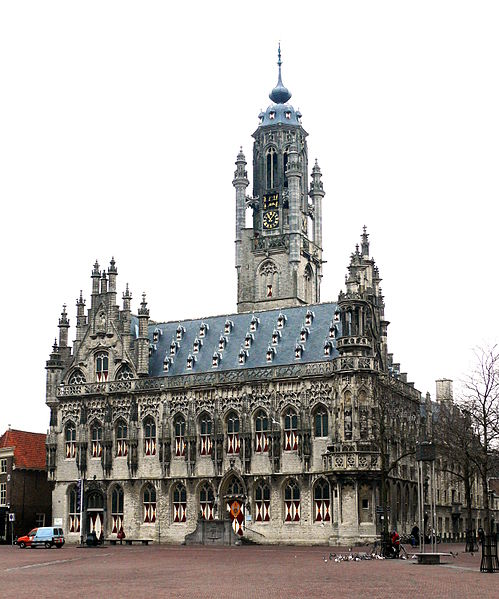
Middelburg Stadhuis
二、自然地理
Geography and climate
Aside from the city of Middelburg, the municipality also includes several population centres, including: Arnemuiden, Kleverskerke, Nieuw- en Sint Joosland and Sint Laurens. The town is close to the coast but the distance of 10-15 km means the winters are somewhat colder with especially lower winterminima and higher summermaxima. It has a temperate oceanic climate (Cfb) with few extremes. Winters tend to be mild, especially when we consider the northern lattitude and summers are cool and precipitation is spreadout evenly over the year. All seasons are warming up by about 0,5 C/decade due to anthropogenic warming. The extreme since 2000 measured 2 km northeast of the city in the countryside with calibratred equipment have been -17,2 C on the 4th of february 2012 and 40,9 C on the 25th of July 2019 . The latter unofficially being a new Dutch aaltime high record, slightly above the 40,7 C measured at Gilzerijen KNMI and 40,6 C in Westdorpe. Vlissingen KNMI measured -11,0 C and 37,5 C on the same dates, clearly showing how much the influence is diminished just 8 km further inland. The climate is warming due to anthropgenic influences, clearly witnessed by the fact that the previous record of 37,5 C was measured just a year before. Also in the past minima have been at and probably below -20 C in wintermonths. Snowcover, days with airfrost and icedays (Tx < 0,0 C) have greatly diminised and with it icespeedskating on the canals, a favourite sports in the wintermonths, has become very infrequent since 2013 especially.
Transportation
Middelburg has a railway station with intercity train connections to Vlissingen, Goes, Roosendaal, Rotterdam, The Hague, Leiden, Schiphol International Airport, Amsterdam, and Almere, among others. Two trains leave every hour in both directions.
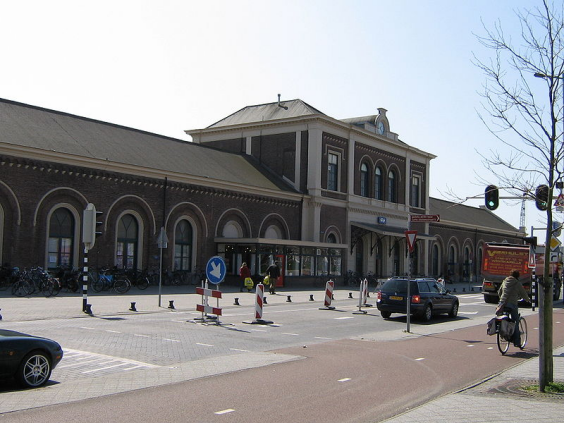
Middelburg railway station.
三、经济发展和规模
Economic activity varies from mining, power generation, metallurgic industries, dry land and subsistence agriculture to eco-tourism.
The strong manufacturing sector is dependent on the relatively cheap supply of coal. Coal mining is mainly carried out by opencast techniques, high extraction underground operations and conventional board and pillar underground operations. The coal mines also provide essential fuel to the local power stations of Hendrina, Komati and Arnot. Major industries in the Middelburg area include Columbus Stainless (Stainless Steel Manufacturing Plant), Middelburg
Ferrochrome (Chrome Plant), and Kanhym Estates (Mill, Piggery and Feedlot) and service industries to the mining components.
Electricity
Largest source of revenue of the municipality Process of upgrading the main intake substations in Middelburg, Hendrina and Kwazamokuhle to cater for the growing electricity demand as well as future developments Two new intake substations are being erected in Aerorand and Nasaret. The Golfsig main intake substations are also in the process of being upgraded.
The medium voltage network is being reinforced and upgraded. Low voltage overhead lines have been removed and the reticulation is underground to improve the reliability of supply Distribution area of Council is provided with area lighting (streetlights/high masts).
New low cost houses are electrified on completion New developments are addressed as and when required Rockdale B substation will provide a new site where new loads can be con-nected. The substation would provide a power source for the 88 KV lines that need to be diverted from the Vulcan substation.
Recent Economic Growth Performance
Estimates indicate that from 2004 to 2008 the growth in the economy of the STLM area slowed down to an average of 2.2% per year. Apart from the normal cyclical slowdown in the RSA economy from the end of 2007, the world economic recession led to a further slowdown in the area in 2008 and spread into 2009. Peaking at 3.5% in 2007, growth in the area slowed down to 1.4% in 2008.
The economy of the area is expected to pick up momentum in 2010 and is estimated to grow by 3.7% on average per year in the decade from 2009 to 2018. Cyclical moves in the economy will, however, still occur and register growth above and below the average of 3.7% during this period.
The economy of the area is estimated to grow faster than the 3.3% average expected for South Africa. Relative rapid price changes in, for instance, commodities and exchange rates movements may oscillate over this period and affect sector contribution and performance over the next decade. This was notably the case in 2008 and thus far in 2009.
Economic Performance over the next decade
It is estimated that new mining development will boost mining growth to 4.1% from the normally expected 3% per year. Mining and manufacturing will remain the mainstay of the area’s economy in 2018 – 53% of GDP (2008 prices). With the re-commissioning of the Komati Power Station that will become fully operational in 2011, the contribution of the electricity sector to GDP will be R764 million in 2008 prices or 5.5% over the next decade.Mining and manufacturing will contribute 54% to real GDP from 2009 to 2018 while the tertiary sector will contribute 38% to real GDP from 2009 to 2018, is estimated to create nearly 50% of the new jobs over next decade. The top ten growth sectors to watch for growth opportunities and linkage effects in the next decade, has been determined and can be obtained from Middelburg Chamber (MCCI) Business Linkage Centre. Although mining provides the largest proposition in monetary terms, its capital intensity and complexities may make it a difficult sector to enter. Personal services will expand substantially while government will have to take up its responsibility. Electricity generation may also be a difficultsector to enter. It appears that ample scope exists with the metal cluster, trade and transport while various business services and building and construction provide the biggest opportunities from a growth perspective.
New Developments to make an impact
The new developments in the area will all contribute to the accelerated growth in the area and create new opportunities and jobs alongside the existing economy. These developments include two new coal mines; the re-commissioned Komati Power Station that will be fully operational by 2011, three new shopping malls that could accommodate trade growth while the new residential area will be the first to make room for growth in the real estate sector which is estimated to contribute some 5.2% to the GDP impact from 2009 to 2018. The new coal mines are estimated to contribute 13.1% to GDP growth over the next decade and the Komati Power Station is expected to contribute 6.4% to the impact on the area’s economy from 2009 to 2018. While the
new development will directly enhance capital formation in the area, the wider impact through their indirect and induced linkages with other business will create a further need for investment in other sectors. The total induced impact through salaries and wages paid over the period will be R12 billion. The new developments will be responsible for about 10% of
the additional household revenue.
Indirect and Induced Economic Impact of New Development The new developments and the local supply chain and their backward linkages play a big part to ensure the dynamics of the local economy. About 17% or R529 million of the impact of the new developments is via indirect means and some 10% or R304 million is estimated to be induced through increased household income in the next decade.
Investment opportunities and Prospects
A capital formation of R35 billion will be needed to sustain the estimated 3.7 % growth per annum from 2009 to 2018, ample opportunities exist for taking part in business activity in the area. The capital formation impact by the new developments alone is estimated to be responsible for 26% of fixed investment up to 2018.Capital inflows will play a vital role in the area to establish new business and employment opportunities as the area is in need of investment from outside the area.Given the unemployment problem, there is a need for higher labour-t capital ratio type of activities as tlong as real labour costs remain competitive with the real cost of capital. New developments will assist in addressing social distress of low income from 2009 to 2018. Businesses, however, will have to deal with an increasing real demand of 39% from all income groups over the next decade.
Potential Import Substitution
Import leakages provide opportunities for local as well as businesses from outside the area to join the local economy. By capturing import leakages, activity will contain and internalize the indirect and induced impacts for the benefit of local businesses and other role players. There is specific scope and potential if imports into the area are viewed from a detailed sector perspective. There exists an import substitution potential of up to the amount of R28 billion over the next decade. Some of the imports are place bound and cannot be easily shifted. Economies of scale play an important role.
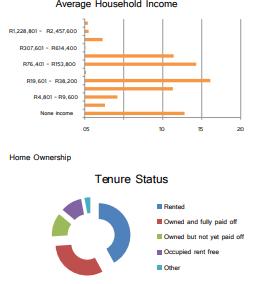
Reference: https://middelburginfo.com/business-guide/wp-content/uploads/2016/08/Economic-Profile-2016.pdf
四、产业特点/重点项目
Projects in development
1, Rittenburg phase III
As a follow-up to the first two phases of the new Rittenburg district, phase III will be realized on the other side of the Vlissingse Watergang, between the watercourse and the Grevelingenstraat. This creates a transition between Rittenburg and the existing buildings in this part of the Stromenwijk. Project developer Sprangers has drawn up a plan (see downloads). We want to bring the zoning plan into procedure after the May holiday.
NUMBER OF RESIDENCES 103
CURRENT PHASE In development
HOUSING TYPES apartments & semi-detached & single-family houses
PLANNING SALES second half of 2020
Project website https://www.sprangersvastgoedontwikkeling.nl/projecten/rittenburg-middelburg
2, Around Sint Laurens
The village of Sint Laurens is located just north of Middelburg. Historical ribbon development on the Noordweg connects the village with Middelburg. Around the village, expansion with new-build homes is planned, for which a plan has been drawn up. A decision has also been taken on the phasing. A zoning plan for the first phase will be in process from 4 June. This mainly concerns houses on the southwest side of the village, supplemented with a few free lots on the north side, along Wilgenhoekweg.
From 4 June, the preliminary zoning plan can be consulted via the website www.ruimtelijkeplannen.nl under identification number NL.IMRO.0687.BPSTLF1-VO01, or by zooming in on the location. The plan can also be viewed by appointment at the trade desk in the city office. You will find a video at www.middelburg.nl/bestemmingsplansintlaurens with an explanation of the plans and an explanation of the procedure.
Number and types of houses
The zoning plan for the first phase makes 56 homes possible. Six somewhat larger free lots will be built on Wilgenhoekweg. A maximum of 48 homes will be made possible in the area to the southwest of the village. We provide a mix of housing types here, including rental homes, life-course residences and free building plots. A private initiative on Wilgenhoekweg has also been included in the plan.
Schedule
The municipality is working on plans for new construction around the village. Concept plans in the village were presented in September 2017, which were subsequently adopted by the city council. At the beginning of 2019, it was decided on the phasing, after which a zoning plan for the first phase was worked out.
This preliminary zoning plan is available for inspection from 4 June to 15 July 2020. This is followed by a procedure for the (whether or not amended) design zoning plan. The planning is that if everything goes smoothly and there are not too many and too difficult responses, the start of sales should be possible in early 2021.
3, Essenvelt
NUMBER OF RESIDENCES About 320 to 400
HOUSING TYPES self-build & apartments & semi-detached houses & detached houses & semi-detached houses
PLANNING SALES End of 2020
On the south side of Middelburg, south of the Erasmus district and Reijershove, in the direction of Oost-Souburg, a new district is being developed.
The area is now being prepared for construction. Water features are being dug and parts of the area are being raised. The contours of the district can therefore be seen quickly. The start of the sale is planned for the end of 2020. This also depends on the speed with which the area can be made ready for construction.
An atmospheric image of the district, including a provisional map, can be found further down on this page (under downloads).
https://youtu.be/4ScfQPyRgV4
Schedule
The preparation of the area started in the second half of 2019 and will continue until 2021. Because the area is partly raised and a long period is required for the soil to settle, it will unfortunately take longer than expected before construction can start. The start of sales is scheduled for 2020, construction is expected to start in 2021.
4, Veerepoort phase V.
From the late 1990s, the Veersepoort district was developed under the supervision of architect Herman Hertzberger. A neighborhood that is characterized by lots of greenery and water, where the buildings are partly clustered in a number of courtyards. The district was completed a number of years ago with the exception of the last phase: Veersepoort phase V, the location of the sports hall and athletics track between Nassaulaan, Fazantenhof and Scholeksterstraat. The district is special because it is on the one hand on the edge of the beautiful and cozy center and on the other hand on the edge of the city, with a direct connection to the N57. In short: in a quiet location but with many amenities at a short distance. The child-friendly neighborhood has a shopping center; schools and sports clubs can be found nearby.
NUMBER OF RESIDENCES 109
HOUSING TYPES apartments & semi-detached houses
PLANNING SALES End of 2020
Schedule
The preliminary zoning plan was brought into procedure in November 2019. The draft zoning plan will be available for vision from 18 June 2020. After the summer holidays, this can then be determined by the municipal council. Sales will start at the end of 2020 at the earliest. Demolition of the sports hall and the removal of the athletics track will start in the short term, and some soil (which will be released elsewhere) will be brought to the location.
Projects with European subsidy
1, Smart Energy Link (SEL)
An energy-neutral Dauwendaele shopping center is part of the Smart Energy Link (SEL) project, made possible with a European subsidy.
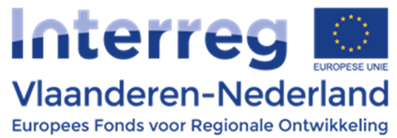
The classic energy model is under threat due to increasing energy production, blackout risks and climate requirements. The Netherlands (with the Energy Agreement) and Flanders (with the Energy Pact) are fully committed to a new energy model in which renewable energy production and energy saving are central. ' Smart Energy Link ' or simply 'SEL' will be able to control energy flows thanks to the development of a smart system, in nine business parks and one shopping center. In Middelburg, efforts are being made to build an energy-neutral Dauwendaele shopping center.
The SEL project aims for a reduction of 10% energy consumption, 28% renewable energy and 5% efficiency gains for the remaining energy requirement for these ten locations by 2020.
Other companies can also rely on support to exchange energy with other companies. In order to be able to learn from each other as much as possible, a uniform methodology and an energy team are available.
Situation
Study phase
Timing
Start date: September 1, 2017
End date: August 31, 2022
Partners
Interreg Flanders-Netherlands, POM East Flanders, POM Antwerp, POM Limburg, POM Flemish Brabant, POM West Flanders, Province of East Flanders, BOM Brabant Development Agency, Municipality of Breda and Municipality of Middelburg.
2, SMART-SPACE
SMART-SPACE is a project in which the Municipality of Middelburg, in collaboration with 10 other European partners, wants to focus on smart and sustainable public lighting. We do this to reduce energy consumption and therefore CO2 emissions by better controlling the lighting.
The objective is to reduce the energy consumption of public lighting by 60%. Together with the partners, a sensor platform will be developed that can control the light intensity via sensors on the lighting poles. Depending on the needs at a given time, the lighting can be dimmed or not. It is important here that this does not endanger the quality of life and public safety.
Partners
SMART-SPACE brings together 11 partners from four countries under the leadership of the City of Ostend:
-- Catholic University of Leuven
-- Ziut BV
-- City of Sint-Niklaas
-- City of Middelburg
-- Comhairle Contae Thiobraid Arann
-- Intemo Special Products BV
-- Eindhoven University of Technology Innovation Lab BV
-- Eindhoven University of Technology Inteligent Lighting Institute
-- University of Picardie Jules Verdes
-- LUCI - Lighting Urban Community International
Projects in Middelburg
Specifically, in the course of 2019-2021 in Middelburg, 416 light points will be replaced in the focus area (historic city center, President Rooseveltlaan and the Jazz and Blues route) in the course of 2019-2021 and sensors will be placed thereon. This makes it possible to automatically adjust the lighting to use. By lighting 'smarter', lighting when public space is used and lighting less when nobody is there, less energy is used.
The general goal of the Municipality of Middelburg for energy savings over the entire area is 35% in 2020 and energy-neutral by 2050. The project goal of the Municipality of Middelburg is to save 60% energy over the area to be replaced. The savings are realized by replacing existing light sources with new LED lighting technology and by applying new smart light technology (sensors and light colors).
In addition to saving energy, the Municipality of Middelburg also wants to investigate at a number of locations whether it is possible to have public lighting burn off-grid, i.e. not connected to the underground electricity network.
Budget
Total project budget: € 5,733,016
Contribution Interreg 2 Seas: € 3,439,809
Budget Municipality of Middelburg: € 622,463
Contribution Interreg 2 Seas: € 373,478
Duration
The SMART-SPACE project will run from May 31, 2018 to July 30, 2021.
Information
More information about SMART-SPACE on the project page:
https://www.nweurope.eu/projects/project-search/smart-space-smart-sustainable-public-spaces-across-the-nwe-region/#tab-1
3, Mobility Opportunities Valuable to Everybody (MOVE)
The European project Mobility Opportunities Valuable to Everybody, referred to in short as 'MOVE', is an international partnership with a Zeeland character that aims to co-create more sustainable mobility solutions in (semi) rural regions and small urban areas.
The solutions generated contribute to increasing the quality of life and accessibility of these regions. The project, which started on 1 September 2018, has a duration of 3 years and the HZ University of Applied Sciences is the initiator of this project.
The other cooperation partners are local authorities, private parties and knowledge institutions from Belgium, Denmark, Germany, England and the Netherlands, each of which will develop pilots in their region with their own specific problems in order to increase sustainable mobility, quality of life and accessibility. bring together both directly and indirectly involved partners in co-creation (existing) developments and new sustainable mobility initiatives to arrive at more feasible and practical solutions for the future.
The aim is to work together in the way in which co-creation is given shape and also the underlying research, both before the pilots and during the pilots take place as much as possible in an equivalent manner, in such a way that much can be learned from each other and experiences can therefore be exchanged.
Project partners MOVE
HZ University of Applied Sciences, Ghent University, Municipality of Middelburg, Inter-municipal association for the development of the Region of Mechelen and the surrounding area, Georg-August-Universität Göttingen, Gate21, The Highlands and Islands Transport, NHS Highland, Advier, Landkreis Northeim and Zweckverband Verkehrsverbund Südniedersachsen .
The Interreg VB North Sea Region Program 2014-2020 gives these project partners room to work together, to make use of each other's expertise in order to arrive at useful solutions that can also be a useful example elsewhere.
Duration
The MOVE project will run from September 2018 to August 2021. MOVE is made possible in part by a contribution from the North Sea Region Program 2014-2020.
-- International project website:
MOVE at European week in Middelburg November 2019
4, VIOLET
'Interreg Europe project VIOLET' is the name of the project that helps owners to preserve their monumental buildings for the future by making them energy efficient.
VIOLET is a partnership between 6 European countries.
Sustainable Construction Desk
For general questions about sustainable modifications to your monument and possible subsidies, please contact the Sustainable Building Desk .
Monument passport
Monuments are unique and therefore require unique energy-saving measures that do not come at the expense of the monumental value. You can have a Monument passport drawn up to find out which adjustments can be made to your building . Here you can read what a Monument passport is and what it can mean for you.
Monumentenwacht employees will come to view your building and you will then receive a Monument passport describing your listed building with tailor-made sustainability advice including insight into the costs and benefits. You can make an appointment for this at the Zeeland Cultural Heritage Foundation (SCEZ) .
Permits
Do you need a permit if you are going to use your moment? Take a look at the Environment Desk . Read here which permits there are in the municipality of Middelburg and how you can apply for them .
5, CUPID
CUPIDO is an Interreg North Sea Region project. Its aim is to use the cultural values and cultural history of Middelburg for the development of opportunities for tourist promotion and new events.
CUPIDO stands for: 'Culture Power: Inspire to Develop Rural Areas'. The project aims to give rural areas with shrinking populations an economic injection by creating economic opportunities. These opportunities are found in the better marketing of the rich cultural history of the region.
Projects in Middelburg
Within the CUPIDO project an attempt is made to use the cultural values and cultural history of Middelburg (for example the Golden Age and VOC) to increase the tourist attractiveness of the city. Ultimately, all of this (also) contributes to an attractive Middelburg for new residents, starting entrepreneurs and students and thus to improving the quality of life in our city and region.
Partners
-- The Netherlands: Municipality of Middelburg, Municipality of Heuvelland
-- Sweden: Länsstyrelsen Värmland, Region Värmland, Sunne Kommun, Rottneros Park Trädgard AB
-- Norway: Nome Kommune, Hogskolen i Sorost Norge
-- Germany: Landkreis Wesermarsch
-- Belgium: VZV Festival Dranouter, HOWEST
-- United Kingdom: Creative Foundation, Highland and Islands Enterprise, University of St. Andrews
Budget
Total project budget: € 4,103,586
Contribution Interreg 2 Seas: € 1,806,793
Budget Municipality of Middelburg: € 677,500
Contribution Interreg 2 Seas: € 338,750
Duration
The CUPIDO project will run from September 1, 2018 to August 31, 2021.
Information
Project website: https://northsearegion.eu/cupido/
Cultural heritage as a source of inspiration:
https://www.middelburg.nl/Inwoners/Projecten_met_Europese_subsidie/Cultureel_erfgoed_als_inspiratiebron
CUPIDO at European week in Middelburg November 2019:
https://www.middelburg.nl/Inwoners/Projecten_met_Europese_subsidie/Europese_week_CUPIDO
6, SHIFFT Sustainable Heating
The cabinet wants to reduce greenhouse gas emissions quickly to combat climate change. CO2 emissions from heating homes must be reduced to 0 by 2050. In the municipality of Middelburg, houses, offices and buildings will also be disconnected from the natural gas network and heated in a different way in the coming years.
The European project SHIFFT is in line with these national and municipal objectives. Within this project, Middelburg is working with knowledge partners and cities such as Bruges and Mechelen on its own municipal vision 'Warmte'. This policy document sets out per neighborhood how and when a neighborhood will be made more sustainable. An implementation plan is being worked out at neighborhood level together with residents and stakeholders. This provides a framework for home owners, network operators, heat companies and municipalities to make investment decisions.
Innovative solutions
The SHIFFT project allows Middelburg to give shape and content to this participation process. The city can get started with the application of various new technologies for heating homes and buildings in a pilot.
Partners
The ten SHIFFT partners are developing sustainable heating strategies for the four partner cities of Mechelen (BE), Bruges (BE), Middelburg (NL) and Fourmies (FR).
The British University of Exeter, the French consultancy CD2E, the Belgian energy agency De Schakel and the Dutch Technical University of Delft provide technical support and are working with local communities to plan for low-carbon heat solutions for buildings in all four target countries. The installation of selected low-carbon heating technologies is then carried out by partners.
Budget
Total project budget: € 5,707,426
Contribution Interreg 2 Seas: € 3,424,456
Budget Municipality of Middelburg: € 901,482.00
Contribution Interreg 2 Seas: € 540,889
Duration
The SHIFFT project will run from February 1, 2019 to September 30, 2022.
More information
Project page website Interreg: https://www.interreg2seas.eu/nl/shifft
SHIFFT at European week in Middelburg November 2019:
https://www.middelburg.nl/Inwoners/Projecten_met_Europese_subsidie/Europees_project_SHIFFT
7, Cool Towns
Cool Towns is a project that focuses on countering the negative effects of climate change. To prevent or limit heat stress as much as possible, attractive solutions are being sought that make cities climate-proof and robust.
Heat resistant
Climate change is causing warmer summers with more drought and heat waves. In many small and medium-sized cities in the 2 Seas area, these higher temperatures negatively impact public health, productivity, well-being, air and water quality and other urban systems. We call these effects 'heat stress'. The need for spatial adaptation to heat stress is clear. But cities still lack essential knowledge and tools to become heat resistant:
-- setting heat targets (existing and desired situation) and making investment decisions (which measures & where);
-- effective heat adaptation measures with additional benefits for other urban issues such as air quality, flood risk;
-- integrate heat resistance into broader climate and spatial strategies.
-- mechanisms to mobilize homeowners and businesses to invest in heat resistance;
-- increase skills and sense of urgency for heat-resistant urban design among urban planners, architects, landscape architects, contractors.
Online decision tool
In a first phase, a heat stress modeling tool will be developed for mapping current and future heat stress and modeling the impact of different intervention scenarios. In a second phase, an online decision-making tool for local authorities will be developed, in which various heat resistance measures with essential decision parameters (such as heat reduction, co-benefits, costs, resources) will be included. The tool is constantly being refined based on data from the 7 pilot projects in the different countries.
Partners
The 13 Cool Town partners are the Municipality of Middelburg (NL, lead partner), Municipality of Breda (NL), Province of East Flanders (BE), City of Ostend (BE), Southend – on-Sea Borough Council (UK), University of Greenwich (UK), University of Picardie Jules Vernes (FR), Green Blue Urban (UK), AUD Agence for urban planning and development of Saint Omer and Flandre interior region (FR), Amsterdam University of Applied Sciences (NL), Sioen Industries (BE) , and Community Agglomeration Saint Omer (FR).
Budget
Total project budget: € 7,948,971
Contribution Interreg 2 Seas: € 3,284,407
Budget Municipality of Middelburg: € 529,665
Contribution Interreg 2 Seas: € 794,497
Duration
The Cool Towns project will run from September 1, 2018 - October 1, 2022.
Project website
More information about this project: https://www.cooltowns.eu/
8, THIRD
The climate is changing. Entrepreneurs are expected to also change. Are you an entrepreneur in the retail trade or catering industry in Middelburg and want to reduce your CO₂ emissions? Then the TERTS project might be something for you.
The energy transition means the transition from electricity from fossil fuels to sustainable energy sources. By no longer using natural gas, petrol or diesel, for example, less CO₂ is emitted. This is necessary to combat climate change.
Switching to renewable energy is easier said than done. Entrepreneurs are also expected to invest in sustainability. They are obliged to operate in an energy-efficient manner where possible. This is quite a challenge for many small and medium-sized companies.
Owners are busy with the daily ins and outs of their business and the hectic pace of everyday life.
In the Flemish-Dutch border region, money has been made available to stimulate the energy transition in the more small-scale companies. Middelburg is participating in the Interreg project TERTS. The project focuses on testing and demonstrating innovative techniques and measures and helps companies to apply these measures.
Subsidy
About 25 companies from the Flemish-Dutch border region can apply for this project. They can implement innovations in their own company through a coaching process. In total there is a subsidy of € 400,000. Entrepreneurs can apply for a subsidy for 50% of their costs.
Duration
The TERTS project will run until August 31, 2021.
Knowing more?
Are you an entrepreneur in the catering industry or retail trade in Middelburg and would you like to know more? Please contact Jack Dooms (0118-675203) or send a message to j.dooms@middelburg.nl .
The TERTS project is funded within the Interreg V program Flanders-Netherlands, the cross-border cooperation program with financial support from the European Regional Development Fund. The municipality is also investing its own money in the project.
More information can be found at: www.grensregio.eu.
五、风景名胜,景点
-- The Abbey
-- Kuiperspoort
-- The "Lange Jan"
-- City Hall
-- Oostkerk
-- Damplein
六、历史文化
The city of Middelburg dates back possibly to the late 8th century or early 9th century. The first mention of Middelburg was as one of three fortified towns (borgs) erected on Walcheren (then an island) to guard against Viking raids. In 844 a monastery was built on the site, which remained an active Catholic foundation until the Reformation. Foundations for Middelburg's "stately and picturesque" main church were first laid in the 10th century; additional construction continued through the Middle Ages.
Middelburg was granted city rights in 1217. During the Middle Ages, it became an important trading centre in the commerce between England and the rising cities of Flanders. The town continued to gain in power and prestige during the 13th and 14th centuries.
From 1559 to 1603, Middelburg was the episcopal see of a Catholic bishopric covering all Zeeland. In the Eighty Years' War, Middelburg was captured from the Spanish forces during a long siege (1572–1574). The northern provinces of the original Low Countries won their independence from their former Spanish Habsburg rulers and formed The Netherlands, a Protestant state. Later, in the 17th century (the Dutch Golden Age), Middelburg became, after Holland's metropolis Amsterdam, the most important center for the East India Company of Republic of the Seven United Netherlands (VOC) or Dutch East India Company.
Middelburg played an important role in the 17th century slave trade.
Samuel Ben Israel, son of Menasseh Ben Israel, is buried in Middelburg at the Sephardic burial site located at the 'Jodengang' outside the citywall. Menasseh Ben Israel negotiated with Cromwell the opening of England, and its colonies, to the Jews. Middelburg also has an Ashkenazic burial site, which is located at the Walensingel inside the city wall. In 1994 the synagogue was restored, as it was partially destroyed during the Second World War. This synagogue was the third one to be built in the Netherlands during the Golden Age. In the hall of the railway station there is a plaque of remembrance for the Jews of Zeeland who started their journey to the death camps from the Middelburg train station.
About a third of the old city centre was devastated by bombs and fire in the early phases of World War II, on May 17, 1940. It is still not certain if German bombers or French artillery were responsible. The town was captured and liberated by British troops during Operation Infatuate on 5 November 1944. After the War, as much of the destroyed part of the old town center was rebuilt and restored along pre-War lines as far as was possible. The city's archives, however, had been incinerated during the German bombardment.
Modern Middelburg has preserved and regained much of its historic and picturesque character. There are lavish 17th and 18th century merchant houses and storehouses standing along canals, of a similar style as found in cities like Amsterdam. The old city moats are still there, as are two of the city gates, the Koepoort Gate and the varkenspoort Gate. Part of the 18th century moat and defence works, however, were demolished in the 19th century to make way for a commercial canal that crosses Walcheren from Vlissingen to Veere. The medieval abbey is still in use today, as a museum and as the seat of the provincial government.
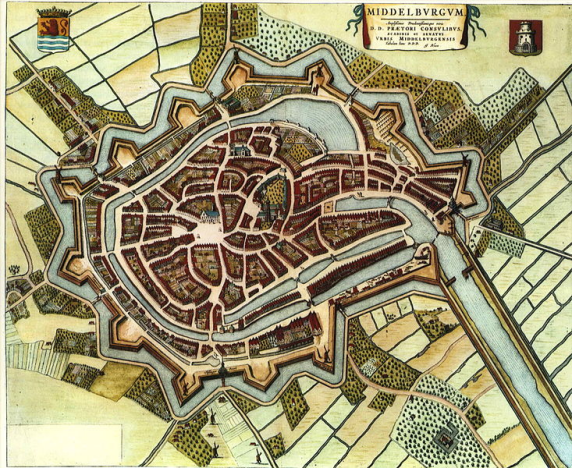
Middelburg in 1652
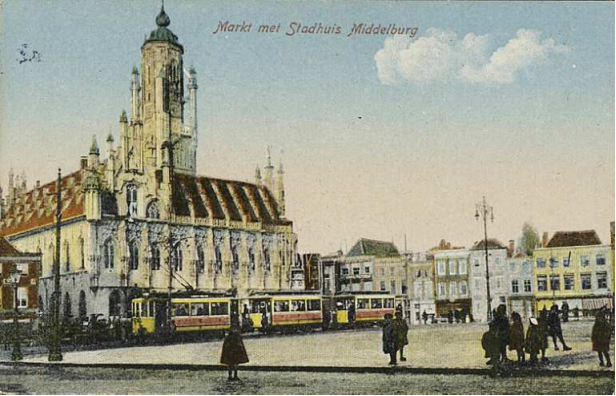
Middelburg's city hall around 1910
七、其他信息
Notable locals
Ambrosius Bosschaert the Elder (1573–1621) was a still life painter of the Dutch Golden Age who worked most of his life in Middelburg. He had three sons, Johannes Bosschaert (1606/08– 1628/29), Ambrosius Bosschaert II (1609–1645) and Abraham Bosschaert the Younger (1612–1643) who were all Dutch Golden Age painters.
The painter Pieter Gaal, (1769–1819) was born, settled and died here, after traveling over Europe to paint
Another well-known citizen of Middelburg was the admiral and explorer Jacob Roggeveen, who was born in the city in 1659 and died there in 1729. Roggeveen discovered Easter Island (Rapa Nui) in the South Pacific Ocean on Easter Sunday, April 6, 1722. Further discoveries on the same journey included islands of the Tuamotu group, now part of French Polynesia.
Petronella Johanna de Timmerman, scientist and poet, was born here in 1723. In 1774 she was inducted as an honorary member of the academy Kunstliefde Spaart Geen Vlijt. Also, she presented the academy with poems, translated from French plays. She died in Utrecht in 1786.
Culture and recreation
When William of Orange decided to found the first university in the Netherlands in 1575, he initially considered locating it in Middelburg. Ultimately he chose Leiden, however, and Middelburg—as well as all of Zeeland—remained without a university until 2004 when University College Roosevelt (formerly known as Roosevelt Academy), affiliated with Utrecht University, was established.
Cultural institutions
Zeeuws Museum Vleeshal Sjakie's Chocolademuseum Zeeuws Archief
Zeeuwse Bibliotheek Centrum Beeldende Kunst
Theaters and Concert halls
Schouwburg Concertzaal Zeeland Spiegeltheater
Minitheater Filmtheater Schuttershof UCR Stand up comedy theatre
Sports
Middelburg has a rugby club, Oemoemenoe, and four football (soccer) clubs: MZVC, Zeelandia Middelburg, Jong Ambon and FC Dauwendaele. Jong Ambon is translated Young Ambon, and consists of mostly Ambonese players. FC Dauwendaele is the main club in Dauwendaele.
八、联系方式
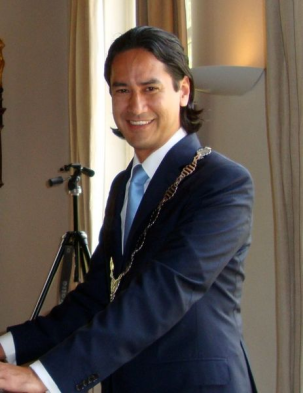
Mayor Harald Bergmann
Telefoon: (0118) 67 54 25
E-mail: h.bergmann@middelburg.nl
Telephone numbers and fax numbers
Tel: (0118) 67 50 00 or 14 0118
From abroad, call the telephone number +31 118 67 50 00
Fax: (0118) 62 37 17
In situations where every second counts, always call 112. Have you seen something that you want to report to the police, but that does not require you to arrive immediately? Call 0900-8844
Visiting address: Kanaalweg 3, 4337 PA Middelburg
Mailing address: PO Box 6000, 4330 LA Middelburg
E-mail: info@middelburg.nl
Twitter: Gemeente Middelburg @Gem_Middelburg
Facebook: Gemeente Middelburg @gemeentemiddelburg
Press information: communicatie@middelburg.nl
